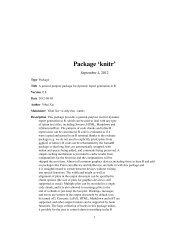Package 'openair'
Package 'openair'
Package 'openair'
Create successful ePaper yourself
Turn your PDF publications into a flip-book with our unique Google optimized e-Paper software.
trendLevel 139y,typedata series in mydata can also be used. (Note: trendLevel does not allowduplication in x, y and type options within a call.)The names of the data series to use as the trendLevel y-axis and for additionalconditioning, respectively. As x above.rotate.axis The rotation to be applied to trendLevel x and y axes. The default, c(90, 0),rotates the x axis by 90 degrees but does not rotate the y axis. (Note: If onlyone value is supplied, this is applied to both axes; if more than two values aresupplied, only the first two are used.)n.levelslimitsThe number of levels to split x, y and type data into if numeric. The default,c(10, 10, 4), cuts numeric x and y data into ten levels and numeric type datainto four levels. (Notes: This option is ignored for date conditioning and factors.If less than three values are supplied, three values are determined by recursion;if more than three values are supplied, only the first three are used.)The colour scale range to use when generating the trendLevel plot.cols The colour set to use to colour the trendLevel surface. cols is passed toopenColours for evaluation. See ?openColours for more details.auto.text Automatic routine text formatting. auto.text = TRUE passes common latticelabelling terms (e.g. xlab for the x-axis, ylab for the y-axis and main for thetitle) to the plot via quickText to provide common text formatting. The alternativeauto.text = FALSE turns this option off and passes any supplied labelsto the plot without modification.key.header,key.footerAdds additional text labels above and/or below the scale key, respectively. Forexample, passing the options key.header = "", key.footer = c("mean","nox")adds the addition text as a scale footer. If enabled (auto.text = TRUE), thesearguments are passed to the scale key (drawOpenKey) via quickText to handleformatting. The term "get.stat.name", used as the default key.header setting,is reserved and automatically adds statistic function names or defaults to"level" when unnamed functions are requested via statistic.key.positionkeystatisticstat.argsLocation where the scale key should be plotted. Allowed arguments currentlyinclude “top”, “right”, “bottom” and “left”.Fine control of the scale key via drawOpenKey. See ?drawOpenKey for furtherdetails.The statistic method to be use to summarise locally binned pollutant measurementswith. Three options are currently encoded: “mean” (default), “max” and“frequency”. (Note: Functions can also be sent directly via statistic. However,this option is still in development and should be used with caution. SeeDetails below.)Additional options to be used with statistic if this is a function. The extraoptions should be supplied as a list of named parameters. (see Details below.)stat.safe.mode An addition protection applied when using functions direclty with statisticthat most users can ignore. This option returns NA instead of running statisticon binned subsamples that are empty. Many common functions terminate withan error meassage when applied to an empty dataset. So, this options provides amechanism to work with such functions. For a very few cases, e.g. for a functionthat counted missing entries, it might need to be set to FALSE (see Details below.)
















